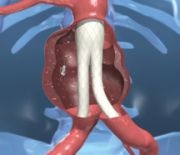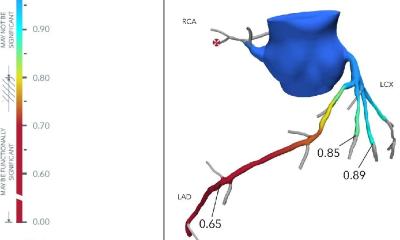Always under doctor's control
A pressure sensor that is implanted into the heart works with an electronic monitoring system that wirelessly measures patient's pulmonary artery pressure. It allows physicians to track the patient's pulmonary artery pressure while they remain at home

Chest pain and shortness of breath are common symptoms that send tens of thousands of heart failure (HF) patients into hospitals each month. Cardiologists at the Bluhm Cardiovascular Institute of Northwestern Memorial Hospital may be able to curb such visits for some of their HF patients sinc they recently use a new wireless pressure sensor technology that allows them to track the pulmonary artery pressure of the subjects while these subjects remain at home.
"Some heart failure patients spend a lot of time in and out of the hospital due to chest pain and trouble breathing," says John B. O'Connell, co-director of the Bluhm Cardiovascular Institute, director of its Center for Heart Failure and professor of medicine at Northwestern University's Feinberg School of Medicine. "At any time, such as when the subject is beginning to feel poorly, we immediately get readings of pulmonary pressure. We are hopeful we can avoid a hospitalization by adjusting the subject's medication based on the pressure recording. As we evaluate the CardioMEMS Wireless Pressure Monitoring System, we see great potential to increase convenience to patients and hospital efficiency by cutting back on frequent trips to the emergency room."
The implanted pressure sensor is about the size of a standard paperclip. It is implanted into the subject's pulmonary artery through a catheter-based procedure from the groin region. The technology that allows for subjects to get readings remotely from home is a proprietary electronic monitoring system that works when they lie on a pillow containing an antenna that interacts with the implanted device to get readings on heart and lung pressures. Northwestern Memorial has implanted three subjects to date and seven more are planned as part of the CHAMPION (CardioMEMS Heart Sensor Allows Monitoring of Pressure to Improve Outcomes in NYHA Class III Patients) clinical study.
As O'Connell explains, when your heart doesn't pump normally, adequate blood (oxygen and nutrients) may not reach your body tissues. When this occurs, the body believes that there is not enough fluid inside its vessels. The body's hormone and nervous systems try to make up for this (or compensate) by holding on to sodium and water in the body, and by increasing heart rate -- all of which are symptoms often seen in HF patients, but in many cases, can be managed with medication. The back pressure in the lungs due to the inability of the heart to pump the blood effectively can be measured and transmitted by this device.
With this system, pressure data is transmitted to a secure database that makes the data available to physicians from a proprietary Web site. Data can also be made available to physicians on a handheld device, like a BlackBerry for instance.
For more information about heart failure or this clinical study please visit the Bluhm Cardiovascular Institute online at http://www.nmh.org/nmh/heart/index.htm. The device is for investigational use only.
Photo: CardioMEMS
19.08.2008









